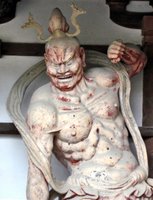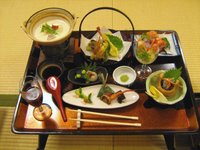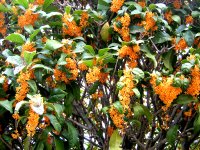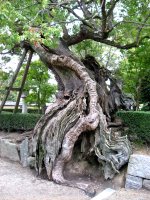
Possibly the oldest wooden buildings in the world are not far from Nara, Japan, and are a distant cousin of the wonderful old growth forests of the northwest. From the look of wood used in Japanese home construction, specimen trees from north America are finding their way to Japan in great quantities. Tim read that great stores of the highly desired straight-grained lumber has been literally sunk in secret locations in anticipation for the time when it’ll be unavailable (and prohibitively expensive).
Getting to Nara was a breeze, and rain accompanied the 35 minute train ride from Kyoto. We had originally planned on renting bicycles in Kyoto and riding the lovely hiker/biker path adjacent to the Katsuragawa (river), but inclement weather (and tiny “mamasan” bikes) squashed that plan. Furthermore, Nara’s Kintetsu train station is conveniently located near the center of town and a short walk to our ryokan. So began yet another memorable Japanese experience.
Guests at a Japanese ryokan are greeted with a bow, slippers, and an introduction to the room: tatami-matted floor, flower display in the corner, and crisply folded yukata (robe) for after the bath. Our choice for the evening was Ryokan Matsumae, and its location perfectly suited our plan of walking to the major shrines and strolling among the ubiquitous deer in the huge downtown park. As deer are the bane of our gardening efforts back home, I failed to isolate the charm in the dirty critters. Japanese, however, absolutely love ’em and I’m sure more than one visitor has had their purse pilfered for more of the deer munchies for sale. The host of our ryokan, Naomi, wore a lovely kimono and made us feel as if we were their personal guests. That’s how it’s supposed to be; I read once that some ryokans wouldn’t even consider taking the reservation of new guests unless recommended by well-known patrons. Matsumae has been around for some time, and hasn’t aged as gracefully as some of the more expensive establishments in Nara. For our purposes, however, it was perfect; affordable, clean, had a private bathroom (as opposed to down the hall commonly found in guest houses), and included dinner and breakfast. Although check-in wasn’t until 3 p.m., Naomi thoughtfully kept our bags while we toured.
 After several hours of sightseeing, we headed back, eager for a hot bath, clean yukata, and a scrumptious meal. Naomi’s husband prepares all the meals, and was influenced by 4 years working at a major hotel in Chicago. He thoughtfully visited with us after we’d cleaned our tray and broadened our knowledge of Japanese food. What we’ve found unique when dining in ryokans are the variety of dishes presented. Rather than sharing large platters, a guest kneels at a low table covered with identically-prepared settings of food, called kaiseki. This is an authentic Japanese dinner featuring the delicacies of the season, each in its own complimentary bowl or dish and individualy-sized portions. There may be a dozen different items served, and none overwhelms the other; you just taste item after item, savoring each distinct flavor and wishing it would never end. At the onset of our meal, we asked our server where to begin; “Freedom” was his reply, and so we were.
After several hours of sightseeing, we headed back, eager for a hot bath, clean yukata, and a scrumptious meal. Naomi’s husband prepares all the meals, and was influenced by 4 years working at a major hotel in Chicago. He thoughtfully visited with us after we’d cleaned our tray and broadened our knowledge of Japanese food. What we’ve found unique when dining in ryokans are the variety of dishes presented. Rather than sharing large platters, a guest kneels at a low table covered with identically-prepared settings of food, called kaiseki. This is an authentic Japanese dinner featuring the delicacies of the season, each in its own complimentary bowl or dish and individualy-sized portions. There may be a dozen different items served, and none overwhelms the other; you just taste item after item, savoring each distinct flavor and wishing it would never end. At the onset of our meal, we asked our server where to begin; “Freedom” was his reply, and so we were.
After dinner, we returned to our rooms in anticipation for a slideshow of the day’s adventures. Alas, we were running low on sake and made a run to the convenience store down the street. Still dressed in our dinner garments (yukata robes), we nevertheless donned wooden slippers left for guests by the entrance and clunk-clunk-clunked down the narrow street to the market, purchased our locally-produced (and deliciously-fresh) sake, and added yet another unique Japanese experience under our sash. Interestingly, Jane read somewhere that some high-end hotel chains in the US are discontinuing offering those wonderful terry-cloth robes to guests because they’ve discovered people wearing them into the coffee shop or, even worse, into the lounge in the evenings. But we’re in Japan, and I mentioned to a skeptical Tim that this is the standard uniform of sumo wrestlers, so he inflated his stomach and felt right at home.
Unlike our busy sightseeing days in Kyoto, our time in Nara was low-keyed and consisted of visits to selected temples and peaceful walks beneath the canopy of ancient trees in the huge park encompassing most of the major shrines. No major fall color was visible yet, but a few maples and ginkos were hinting that a color change was imminent. On our walk to the JR (Japan Rail) station about a mile from our ryokan, we discovered an interesting shop where items were priced a fraction of what we’d seen in the depatos (department stores) in Kyoto. Many were lovely ceramics still in the finely-crafted wooden boxes reserved for finer items and not all were new. Many displayed the patina of much-loved heirloom treasures, and we speculated that the proprietor had purchased the eclectic collection in estate sales. We had a ball lifting, moving, and opening boxes, many hidden deep in the recesses of shelves—and even found some treasures. What we opted not to carry, we captured digitally for the evening’s slideshow.
 After a short train ride, we had yet another 20-minute stroll to the Horyuji temple complex, allegedly the oldest wooden structure in the world. As opposed to bus tours, there’re many compelling reason for walking the roads-less-traveled; wonderful surprises everywhere you look and, since you’re walking, you stop, explore, eat, or simply savor the lovely kinmokusei that are blossoming everywhere. Their fragrance is breathtaking (a little like walking through a forest of daphne) and, while the plant has a resemblance of an evergreen shrub the other 50 weeks of the year, theses gems have made our jaunts through the neighborhoods even more memorable. As we neared the 1,200-year-old Horyuji Temple, Tim and I were marveling at local houses and construction techniques and momentarily lost Sooney and Jane. We discovered them blissfully licking the local ice cream cones usually sold wherever tourists assemble. What sets these deserts apart is the soft texture and subtle seasonal flavors: rose, loquat, blue berry, persimmon, green tea, sweet potato, azuki bean, and roasted barley tea. Oh, and an optional vanilla for the less adventuresome. Another interesting thing about the cones are, uh, the cones. They all feature a lip resembling an upright Morning Glory flower that conveniently catches any errant drips.
After a short train ride, we had yet another 20-minute stroll to the Horyuji temple complex, allegedly the oldest wooden structure in the world. As opposed to bus tours, there’re many compelling reason for walking the roads-less-traveled; wonderful surprises everywhere you look and, since you’re walking, you stop, explore, eat, or simply savor the lovely kinmokusei that are blossoming everywhere. Their fragrance is breathtaking (a little like walking through a forest of daphne) and, while the plant has a resemblance of an evergreen shrub the other 50 weeks of the year, theses gems have made our jaunts through the neighborhoods even more memorable. As we neared the 1,200-year-old Horyuji Temple, Tim and I were marveling at local houses and construction techniques and momentarily lost Sooney and Jane. We discovered them blissfully licking the local ice cream cones usually sold wherever tourists assemble. What sets these deserts apart is the soft texture and subtle seasonal flavors: rose, loquat, blue berry, persimmon, green tea, sweet potato, azuki bean, and roasted barley tea. Oh, and an optional vanilla for the less adventuresome. Another interesting thing about the cones are, uh, the cones. They all feature a lip resembling an upright Morning Glory flower that conveniently catches any errant drips.
 After exploring the fabulous buildings and companion gardens (there were ancient trees resting on wooden supports that resembled temple ancestors walking with the aid of canes), we visited a nearby housewares shop. It was here you purchased pots, pans, chopsticks, the candle holders left on grave stones, sake cups (for both personal consumption and temple offerings) and, Sooney’s favorite, jika tabbies. These are the rubber-soled cloth shoes worn by light construction workers and gardeners that have a separate place for the big toe and resemble gloves for the feet. They’re perfect for climbing around in trees which seems to be a full-time occupation for pruners in the fall; we’ve never seen such manicured gardens in our lives. Unlike the wild, natural growth of forests, each specimen in these moss-covered gardens has its own place—serene and exquisitely crafted—at an cost we couldn’t begin to imagine. And more than tidy gardens have caught our attention; Japan is clean beyond imagination. There’s hardly a speck of litter anywhere; the trains haven’t a bit of graffiti on them, temple grounds are are swept daily, shopkeepers daily wash sidewalks fronting their stores and, even in the homeless camps beneath bridges, the occupants remove their shoes before stepping on newspaper floors. These are, perhaps, gross over-generalizations, but what we see is what we see.
After exploring the fabulous buildings and companion gardens (there were ancient trees resting on wooden supports that resembled temple ancestors walking with the aid of canes), we visited a nearby housewares shop. It was here you purchased pots, pans, chopsticks, the candle holders left on grave stones, sake cups (for both personal consumption and temple offerings) and, Sooney’s favorite, jika tabbies. These are the rubber-soled cloth shoes worn by light construction workers and gardeners that have a separate place for the big toe and resemble gloves for the feet. They’re perfect for climbing around in trees which seems to be a full-time occupation for pruners in the fall; we’ve never seen such manicured gardens in our lives. Unlike the wild, natural growth of forests, each specimen in these moss-covered gardens has its own place—serene and exquisitely crafted—at an cost we couldn’t begin to imagine. And more than tidy gardens have caught our attention; Japan is clean beyond imagination. There’s hardly a speck of litter anywhere; the trains haven’t a bit of graffiti on them, temple grounds are are swept daily, shopkeepers daily wash sidewalks fronting their stores and, even in the homeless camps beneath bridges, the occupants remove their shoes before stepping on newspaper floors. These are, perhaps, gross over-generalizations, but what we see is what we see.
All 18 photo galleries representing 3 weeks in Japan are compiled in our Photo Galleries 2007.
